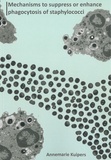Mechanisms to suppress or enhance phagocytosis of Staphylococci

Kuipers, Annemarie
- Promoter:
- Prof.dr. J.A.G. (Jos) van Strijp & prof.dr. V.P.M.G. (Victor) Rutten
- Co-promoter:
- Dr. S.H.M. (Suzan) Rooijakkers
- Research group:
- Rooijakkers , Rutten , Strijp
- Date:
- June 16, 2016
- Time:
- 14:30 h
Summary
Staphylococcus aureus (S. aureus) is a major human pathogen responsible for many community- and hospital-acquired infections. In humans, host clearance of S. aureus critically depends on proper engulfment (phagocytosis) and intracellular killing by phagocytic cells such as neutrophils. In order to effectively engulf S. aureus, neutrophils require the help of antibodies binding the bacterial surface and recognition by the complement system, an extensive network of plasma proteins. This recognition will lead to the massive labeling of a bacterial surface with complement protein C3b, resulting in phagocytosis. In order to resist phagocytic clearance, S. aureus has evolved various immuno-modulatory mechanisms that frustrate the process of phagocytosis. For instance, S. aureus produces several proteins that modulate binding of IgG to the bacterial surface or inhibit recognition of surface-bound IgG. Also, S. aureus secretes multiple proteins that block activation of complement. Furthermore, S. aureus has developed several ways to shield its surface from recognition by the host immune system, such as the production of capsular polysaccharides. Treatment of S. aureus infections in hospitalized patients is complicated by the rise of antibiotic-resistant bacteria (MRSA, VRSA). Therefore, alternative treatment strategies for this pathogen are being explored and monoclonal antibody therapy is considered an attractive strategy to treat or prevent infections with antibiotic-resistant bacteria, like S. aureus.
In this thesis we show one of the mechanism S. aureus has developed to prevent phagocytic uptake, using the Extracellular fibrinogen binding protein (Efb). Although this small secreted protein was mainly known for its complement-inhibitory functions, we now describe this protein has potent anti-phagocytic functions. This is mediated by simultaneous binding to bacterium-bound C3b (via the Efb C-terminal domain) and soluble fibrinogen (via the Efb N-terminal domain). Thereby, Efb shields bacteria with a thick layer of fibrinogen and prevents recognition of surface-associated opsonins by phagocytic cells. We show this mechanism on various strains of S. aureus, both capsule-negative as well as encapsulated strains. Additionally, we investigate the mechanisms of antibodies targeting S. aureus in proper activation of the complement system.
Altogether this thesis provides basic insights into the molecular battle between S. aureus infections and human immune defenses.